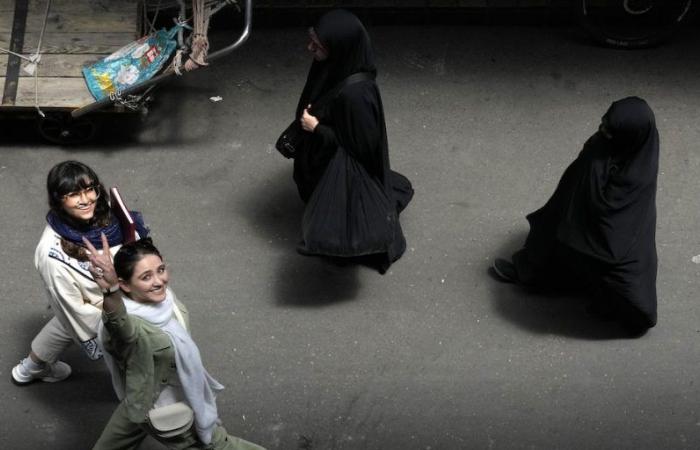Loading player
In recent weeks, the obligation for Iranian women to wear the headscarf, or hijab, has become an important issue in the campaign for Iran’s presidential elections, which will be held on Friday 28 June. The law that obliges women to wear the hijab in public places was the most discussed topic during the third television debate between the six presidential candidates, held last week: the opinions expressed were varied, but everyone agreed at least to words that using violence against women who refuse to wear the veil is a behavior to be avoided.
Today, Iran remains the only country in the world, along with Afghanistan, to have such harsh laws on the obligation to wear the veil: not wearing it is usually punished with a fine or a prison sentence that can last between 10 days and two months, but also with the impoundment of the car if the woman is seen not wearing the veil while driving it. The issue in Iran had become exceptionally controversial following the large demonstrations that took place in Iran in 2022 after the death of Mahsa Amini, a woman who died in custody after she was arrested by the religious police for not wearing the veil correctly.
The protests over the death of Mahsa Amini went on for months, not only in the big cities, and became protests for the defense of women’s rights and against the Iranian religious regime. They were violently repressed by the regime, an operation that led to the deaths of over 500 people, including through death sentences carried out after summary trials, and the detention of over 22 thousand. The enormous following of the protests, however, contributed to a change in the Iranian population’s opinion regarding the veil, and this was also reflected in the electoral campaign.
It is highly unlikely that the law on compulsory veiling will be repealed or even reformed in Iran, but despite this, several women’s rights activists believe that the fact that it has become a topic of discussion in the election campaign, and that even ultra-conservative candidates are talking about it, is in itself a victory for the protests. Today, not wearing a veil on the street is much more accepted and normalized, especially among young women living in large cities. The effect this has had on the religious police has been twofold: some officers now simply ask women to put their headscarves back on if they encounter them on the street without them, while others adopt much more serious punishments.
– Read also: In Iran the attempted revolution has turned into resistance
Among the six presidential candidates, the only one to support a significant reduction in the obligation to wear the hijab was the former Health Minister Masoud Pezeshkian, the only “reformist” candidate (by the ultra-conservative standards of the Iranian political class ) and which has given hope to those who would like the situation in Iran to change. Pezeshkian has never explicitly opposed the compulsory wearing of the veil, but in recent weeks he had said that «a thought cannot be implemented by force. […] This method will not go anywhere and we must not hate each other. As far as possible, I will stop the control patrols”: a concept she reiterated during the televised debate when she said that “we cannot force women to wear the hijab”.
His campaign had already been criticized by more conservative politicians for having used the song “Baraye”, considered the anthem of the protests over the death of Mahsa Amini, during his rallies and for having women who were not wearing the mask speak from the stage. hijab.
A supporter of Masoud Pezeshkian does not wear an Islamic headscarf and holds a photo of Mirhossein Mousavi, opposition leader in the late 2000s and now under house arrest, during a Pezeshkian rally on June 23, 2024 (AP Photo/Vahid Salemi)
However, Pezeshkian’s presence is not the only novelty, given that the other five candidates, all conservative and ultra-conservative, also expressed themselves in a more moderate way on the issue during the debate. Following in Pezeshkian’s wake, also the candidate Mostafa Pourmohammadi He said that if he became president he would abolish laws currently being approved by parliament that would make punishments for women who do not wear the veil harsher.
In September 2023, the Iranian parliament passed a law that would increase fines to 8,000 euros for women who do not wear the veil and up to 10 years in prison for those who do not comply with this rule “in an organized manner and encourage others to follow suit,” but it has not yet been definitively approved by the Council of Guardians of the Constitution. The parliament is also working on a law that would impose other punishments, including the denial of social services, the imposition of travel bans and the ability for the judiciary to withdraw funds from their bank accounts.
Some presidential candidates are directly involved in drafting these laws, notably the speaker of parliament Mohammad-Bagher Ghalibaf, MP Masoud Pezeshkian and Tehran mayor Alireza Zakani, but during the debate they too criticized the violent methods used by the police to enforce the laws currently in force.
Ghalibaf, for example, defined the refusal of Iranian women to wear the hijab as “a scourge on society”, but also said that “some of the behavior of the police […] are not correct and we absolutely must prevent them from happening,” probably referring to episodes such as the one in December 2023, when the police were accused of sending a 16-year-old girl into a coma because she was not wearing her hijab properly.
Even radical candidate Saeed Jalili, former secretary of the National Security Council, who is considered the second most likely winner behind Ghalibaf, remained very vague on the issue and limited himself to saying that “the enemies have focused on the women’s issue because it is one of our strengths.”
The six candidates for the presidential elections in Iran at the end of the television debate on 25 June 2024: from left, Masoud Pezeshkian, Alireza Zakani, Mostafa Pourmohammadi, Amirhossein Ghazizadeh Hashemi, Mohammad Bagher Qalibaf and Saeed Jalili (Morteza Fakhri Nezhad/IRIB via AP)
While some activists have seen this change as a positive, others argue that it is just words to rally support at a time when conservative politicians fear that a large portion of the population will mobilize to vote for Pezeshkian, after years of declining voter turnout and rising public discontent. Narges Mohammadi, a Nobel Peace Prize winner and one of Iran’s most prominent women’s rights activists who is currently serving a 10-year prison sentence, issued a statement calling on people to boycott the elections, calling them a farce.
– Read also: In the presidential elections in Iran, conservative candidates are thinking of forming a coalition
In this context it is important to remember that the president does not have much control over the abolition of a law as important for the identity of the Iranian regime as the compulsory veil: it however depends on the Supreme Leader of Iran Ali Khamenei, the main political authority and religious of the country. Furthermore, although there has been a partial change in public opinion on the Islamic headscarf, many still support rigorous enforcement of the law that makes it mandatory and many women are still arrested if they do not wear it. Some also said they were summoned to court via text message after being filmed by security cameras while they were not wearing it and were fined for it.
– Read also: What is the Iranian Religious Police?
In the years immediately preceding the 2022 protests, there had not been much talk in Iranian politics about the Islamic headscarf, although it has always been considered a political symbol, which has historically generated protests. After taking power at the end of the First World War, Shah Reza Pahlavi imposed a forced Westernization of Iran and in 1936 issued a decree banning women from wearing the veil in all its versions in public. In 1941 the ban was removed but the government actively discriminated against women who carried it, for example by excluding them from holding public office. In the meantime, the popularity of the regime was declining and wearing the veil became a symbol of rebellion: not only women belonging to the more conservative classes, but also those of the middle class, educated and wealthy, began to do so as a sign of protest.
In 1979 the Islamic revolution forced the Shah to flee the country and in his place Ayatollah Ruhollah Khomeini, a well-known Shiite religious leader, was installed as Supreme Leader (the main Iranian political and religious authority). Before long, Khomeini imposed a rigid theocracy, ousting non-religious people who had also contributed to the revolution from positions of power. One of the most symbolic changes was the introduction of the obligation for all women to wear the veil in public, which was highly contested. In the following years, laws were issued that established corporal punishment, in particular whipping, for women who left the house without a veil, making it no longer a symbol of liberation from the Shah’s regime, but a symbol of oppression from the regime of the ayatollahs.
– Read also: A Brief History of the Islamic Veil in Iran






